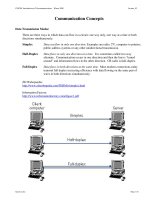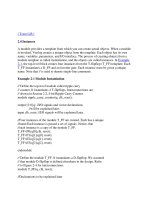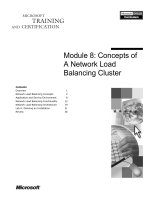Chapter2: Fundamental concepts ppt
Bạn đang xem bản rút gọn của tài liệu. Xem và tải ngay bản đầy đủ của tài liệu tại đây (550.78 KB, 25 trang )
1
NATIONAL UNIVERSITY OF HO CHI MINH CITY
UNIVERSITY OF INFORMATION TECHNOLOGY
FACULTY OF COMPUTER ENGINEERING
LECTURE
Lecturer: Lam Duc Khai
VERILOG
Hardware Description Language
Chapter2: Fundamental concepts
Subject:
2
Agenda
1. Chapter 1: Introduction ( Week1)
2. Chapter 2: Fundamental concepts (Week1)
3. Chapter 3: Modules and hierarchical structure (Week2)
4. Chapter 4: Primitive Gates – Switches – User defined
primitives (Week2)
5. Chapter 5: Structural model (Week3)
6. Chapter 6: Behavioral model – Combination circuit (Week4)
7. Chapter 7: Behavioral model – Sequential circuit (Week5)
8. Chapter 8: Tasks and Functions (Week6)
9. Chapter 9: State machines (Week6)
10. Chaper 10: Testbench and verification (Week7)
3
Contents
Chapter 2: Fundamental concepts
Lexical conventions
Data types
Verilog in Hardware Design
4
Lexical conventions
Comments :
- Two forms to introduce comments:
1. //……….//
2. /*…… */
Ex:
module FlipFlop (din, clk, qout);
input din, clk;
output qout;
reg qout;
// At the rising edge of clk, qout <= din //
/* At the rising edge of clk, qout <= din */
always @ (posedge clk) begin
qout <= #8 din;
endmodule
5
Numbers :
- Two forms to express numbers:
1. 37 32 bit decimal 37
2. <size>’<base_format><number>
Ex:
10’hFA 10 bits hexadecimal number FA (00_1111_1010)
1’b0 1 bit binary number 0 (0)
6’d30 6 bits decimal number (011110), decimal 30
15’o10752 15 bits octal number (001,000,111,101,010),
decimal 4586
4’b0 is equal to 4’b0000
4’b1 is equal to 4’b0001
4’bz is equal to 4’bzzzz
4’bx is equal to 4’bxxxx
-8 ‘d 6 The two’s complement of 6, held in 8 bits
Lexical conventions
6
Strings :
-A string is a sequence of characters enclosed by double quotes and all
contained on a single line. Verilog treats strings used as operands in
expressions and assignments as a sequence of eight-bit ASCII values, with one
eight-bit ASCII value representing one character.
Ex:
“Hello world”
String variable declaration:
- To store the string “Hello world” requires a register 8*11, or 88 bits wide:
reg [8*11:1] stringvar;
initial
begin
stringvar = “Hello world”;
end
Lexical conventions
7
Strings manipulation:
- It can be manipulated with strings.
Ex:
module string_test;
reg [8*11:1] stringvar;
initial
begin
stringvar = “Hello”;
$display(“%s is stored as %h”,stringvar,stringvar);
stringvar = {stringvar,” world”};
$display(“%s is stored as %h”,stringvar,stringvar);
end
endmodule
Lexical conventions
8
Special character in string
Percent (%) character%%
A character specified in 1-3 octal digits (0 <= d <= 7)\ddd
Double quote (*) character\*
Slash (\) character\\
Tab character\t
New line character\n
Character produces by escape stringEscape string
Lexical conventions
9
Keywords :
- Keywords are used to define the language constructs. There are a lot of
keywords in Verilog HDL. (Refer to Verilog books)
- All keywords are defined in lower case
- Do not use keywords as user’s definition.
Examples :
module, endmodule fork, join
input, output, inout specific, endspecific
reg, integer, real, time timescale
not, and, nand, or, nor, xor include
parameter undef
begin, end nmos, pmos,…
Lexical conventions
10
System tasks and functions :
– They are considered part of the Verilog HDL. These system tasks and functions
are divided into some categories as follows:
+ Display tasks : $display, $monitor, $strobe, $writ, $dumpfile, $dumpvars…
+ File I/O tasks : $fclose, $fdisplay, $swrite, $fread, $sdf_annotate,
$readmemb, $readmemh…
+ Simulation control tasks: $finish, $stop
+ Math functions: $ln, $log10, $exp, $sqrt, $sin, $cos, $asin, $acos…
Ex:
$display (“Hello world”);
$finish;
Lexical conventions
11
System tasks and functions (cont’d)
- $time - returns the current simulation time
- $display - similar to printf in C
- $stop - stops simultion
- $finish - ends simulation
- $monitor – monitor simulation
- $readmemh - load memory array from text file in hex format
– Many more …
Lexical conventions
12
Compiler directives
– The scope of a compiler directive extends from the point where it is processed,
across all files processed, to the point where another compiler directive
supersedes it or the processing completes.
– There are some common compiler directives:
+ `celldefine
+ `endcelldefine
+ `define
+ `else
+ `elsif
+ `ifdef
+ `endif
+ `include
+ …
Lexical conventions
13
Data types
Value set :
- Four basic values:
1. 0 – represents a logic zero, logic low, ground or false condition.
2. 1 – represents a logic one, logic high, power or true condition.
3. x – represents an unknown logic value.
4. z – represents a high-impedance, unconnected, tri-state.
‘0’
‘1’
‘X’
‘Z’
0
14
Nets data types
- Nets data types present the physical connections between devices. A net
does not store a value, it must be driven by a gate or continuous
assignment. If a net variable has no driver, then it has a high-impedance
value (z).
- Net data type can be declared by following keywords : wire, wand, wor,
supply0, supply1, …
- Cannot be assigned in an initial or always block
• Net data type represent physical connections between structural entities.
• A net must be driven by a driver, such as a gate or a continuous assignment.
• Verilog automatically propagates new values onto a net when the drivers
change value.
Ex:
- wire w1, w2; // declares 2 wires
- wand w;
Data types
15
Net data types (cont’d)
– Used in structural modeling and continuous assignment
– Types of nets:
• wire, tri : default
• wor, trior : wire-ORed
• wand, triand : wire-ANDed
• trireg : with capacitive storage
• tri1 : pull high
• tri0 ; pull low
• supply1 ; power
• supply0 ; ground
Data types
16
Registers
- Registers present abstract storage elements. Registers are data types that hold
the assigned values until a new value assigned to it. A new value can be
assigned to registers only by using procedural assignments.
- Register data type can be declared by using “reg” keyword.
– Don’t confuse reg assignments with the combinational continuous assign
statement! (more soon)
– Reg should only be used with always blocks (sequential logic)
Ex:
- reg a; // a scalar register
– reg[3:0] v; // a 4-bit vector register made up of (from most to least significant)
v[3], v[2], v[1] and v[0]
– reg [1:4] b; // a 4-bit vector register
– reg signed [0:3] signed_reg; // 4-bit signed register with a range of -8 to +7
– reg signed [0:3] signed_mem [99:0] // 100 words with a range of -8 to +7
Data types
17
Register (cont’d)
– A variables used in behavioral description
– A storage device or a temporary variable
– Types of register:
• reg : unsigned integer variables of varying bit width
• integer : 32-bit signed integer
• real : signed floating-point
• time : 64-bit unsigned integer
Data types
18
Variable declarations
– Declaring a net
wire [<range>] <net_name> [<net_name>*];
Range is specified as [MSb:LSb]. Default is one bit wide
– Declaring a register
reg [<range>] <reg_name> [<reg_name>*];
– Declaring memory
reg [<range>] <memory_name> [<start_addr> : <end_addr>];
– Examples
reg r; // 1-bit reg variable
wire w1, w2; // 2 1-bit wire variable
reg [7:0] vreg; // 8-bit register
reg [7:0] memory [0:1023]; a 1 KB memory
Data types
19
Correct data types for ports
inout
input output
net net
net
net
Register/net register/net
Module
Port and Data types
20
Example
module MM (Q,A,CLK) ;
output Q ;
input A,CLK;
wire B
reg Q ;
assign B = ! A;
always @ (negedge CLK)
Q <= B;
endmodule
CLK
D
CLK
Q
A
B
Module : MM
Data types
21
Signed objects:
Ex:
wire signed [3:0] signed_wire; // range -8 <-> +7
reg signed [3:0] signed_reg; // range -8 <-> +7
reg signed [3:0] signed_mem [99:0] // 100 words range -8 <-> +7
- A signed value will not cross hierarchical boundaries. If you want a signed
value in other modules in a hierarchy, you must declare them in each of the
modules where signed arithmetic is necessary.
Data types
22
Scalar and Vector:
– A net or reg declaration without a <range> specification is one bit wide; that
is, it is scalar.Multiple bit net and reg data types are declared by specifying a
<range>, and are known as vectors.
Ex:
wire w1, w2; // declares 2 scalar nets
reg a; // declares a scalar register
wire [3:0] addr; // declare a vector net
reg[3:0] v; // declare a vector register
- Vector can be declared at [high# : low#] or [low# : high#], but the left number
in the squared brackets is always the most significant bit of the vector
-
Vectors can be declared only for nets and reg data types. (Vector declaration
for integer, real, realtime, and time data types are illegal.)
Data types
23
Parameters:
- Parameters are constants. There are two types of parameters: module
parameters and specify parameters.
- Parameters are not variables, they are used for “per instance” constants.
- For global constants, using ‘define …
+ Module parameters:
– parameter msb = 7; // defines msb as a constant value 7
– parameter e = 25, f = 9; // defines two constant numbers
– parameter r = 5.7; // declares r as a real parameter
– parameter byte_size = 8,
– parameter average_delay = (r + f) / 2;
– parameter signed [3:0] mux_selector = 0;
– parameter real r1 = 3.5e17;
Data types
24
Verilog in Hardware Design
Verilog design
Structural model Behavioral model
Combinational logic Sequential logic Combinational logic Sequential logic
• Combinational Logic
Logic without state variables
Examples: adders, multiplexers,
decoders, encoders
No clock involved
• Sequential Logic
Logic with state variables
State variables: latches, flip-flops,
registers, memories
Clocked
State machines, multi-cycle arithmetic,
processors
Gate primitives and/or other modules
Like the programming language but not
25
END









